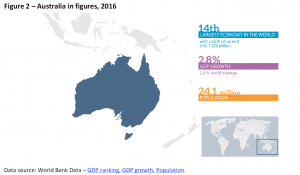In recent years, the EU has also completed or has been negotiating trade agreements throughout the region. For example, FTAs have been concluded with South Korea, Singapore and Vietnam; elsewhere in the region, negotiations have been launched with Indonesia, and are close to completion with Japan.
As experts point out, the EU-Canada Comprehensive Economic and Trade Agreement (CETA) could serve as a benchmark for the EU-Australia FTA negotiations, given similarities such as the size of the Canadian and Australian economies and the ranking of the EU as their trade partner. Among the most relevant elements of the CETA, experts note the negative listing approach to services trade liberalisation, arrangements providing for the mutual recognition of professional qualifications and the temporary mobility of service suppliers (often referred to as ‘Mode 4’), and the agreement on the opening of tendering procedures to sub-national authorities. Although important tariff reductions on agricultural products were reached in CETA, it has been pointed out that EU agricultural exports to Canada have been consistently higher than its imports for several years, which is not the case for Australia.
At this stage, it is too early to say how the EU-Australia FTA talks will be influenced by the Brexit negotiations, particularly when it comes to agriculture. The UK accounts for a dominant share of EU imports of Australian beef, sheep meat and wine (for instance, on average, 64 % of Australia’s yearly exports of beef and sheep meat has gone to the UK over the last decade).








Be the first to write a comment.